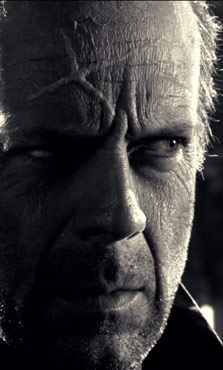 “Sin City” is Robert Rodriguez’ least personal film to date, even less so than “Spy Kids”. Perhaps that is because of the directorial contributions of Frank Miller and Quentin Tarantino. I think it has more to do with the fact that for two hours Rodriguez almost literally turns his back on the art of cinema. “Sin City” is still a movie, but with its painted, cartoonish fidelity to the graphic novels on which it’s based, this film’s fatal flaw is the very thing for which it has earned the highest praise: it’s Frank Miller’s graphic novel translated perfectly onto the big screen. “Sin City” is Robert Rodriguez’ least personal film to date, even less so than “Spy Kids”. Perhaps that is because of the directorial contributions of Frank Miller and Quentin Tarantino. I think it has more to do with the fact that for two hours Rodriguez almost literally turns his back on the art of cinema. “Sin City” is still a movie, but with its painted, cartoonish fidelity to the graphic novels on which it’s based, this film’s fatal flaw is the very thing for which it has earned the highest praise: it’s Frank Miller’s graphic novel translated perfectly onto the big screen.
With “Once Upon A Time In Mexico”, Rodriguez earned the right to be called one of the most brilliant directors of his generation, and there were moments in that film that surpassed even Tarantino. “Sin City” is a different kind of animal altogether, and barely warrants criticism. It illustrates the madness of attempting literal translations of other media into cinema. There has to be more than just the thrill of seeing a comic book come to life at 24 frames per second.
Does “Sin City” deliver on some good laughs, blood-spattering violence, and shadowy noir? Sure. There’s a parade of Miller’s indelible images, many of which are deeply satisfying entries to the genre. A few include Marv’s night with Goldie, almost every shot of the reflective eyeglasses on Elijah Wood’s cannibal, Benicio Del Toro’s talkative corpse, and Clive Owen’s mercenary Dwight leaping from a building like a superhero. The three interlocking stories, though very similar, are told with a wealth of inky atmospherics that play out like pulp fiction to end all pulp fiction.
None of it amounts to a whole lot. The exaggerated violence on the page appears ludicrous when recast in the starker logic of filmed physics. When Hartigan (a raspy Bruce Willis) yanks out Yellow Bastard’s genitals with his hand, it’s readily apparent that this was probably an unforgettable scene in the graphic novel, but here it just appears like a cheap grand guignol stunt. The unadaptable part of a graphic novel is the reader’s imagination, which populates the spaces between the panels with all manner of suppositions and even additional images.
That’s absent here, and strangely what is shown undermines rather than expands on the original, static images. With their sleekness and fluid menace, the kinetics of “Sin City” are amazing to watch, and yet, paradoxically, they’re as bogus and clunky as the fistfights exploding with “Pow!” graphics on the old “Batman” TV series. Frank Miller’s fans may have complained, but Rodriguez should have shown less loyalty to the graphic novel and more to his own expert feel for cinema. He has his fans, too. |